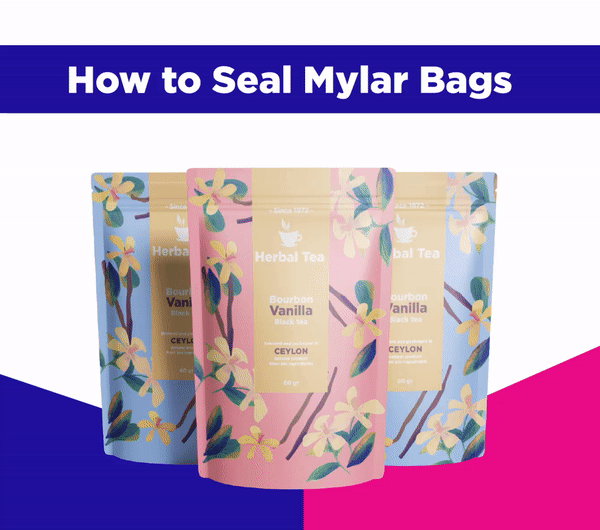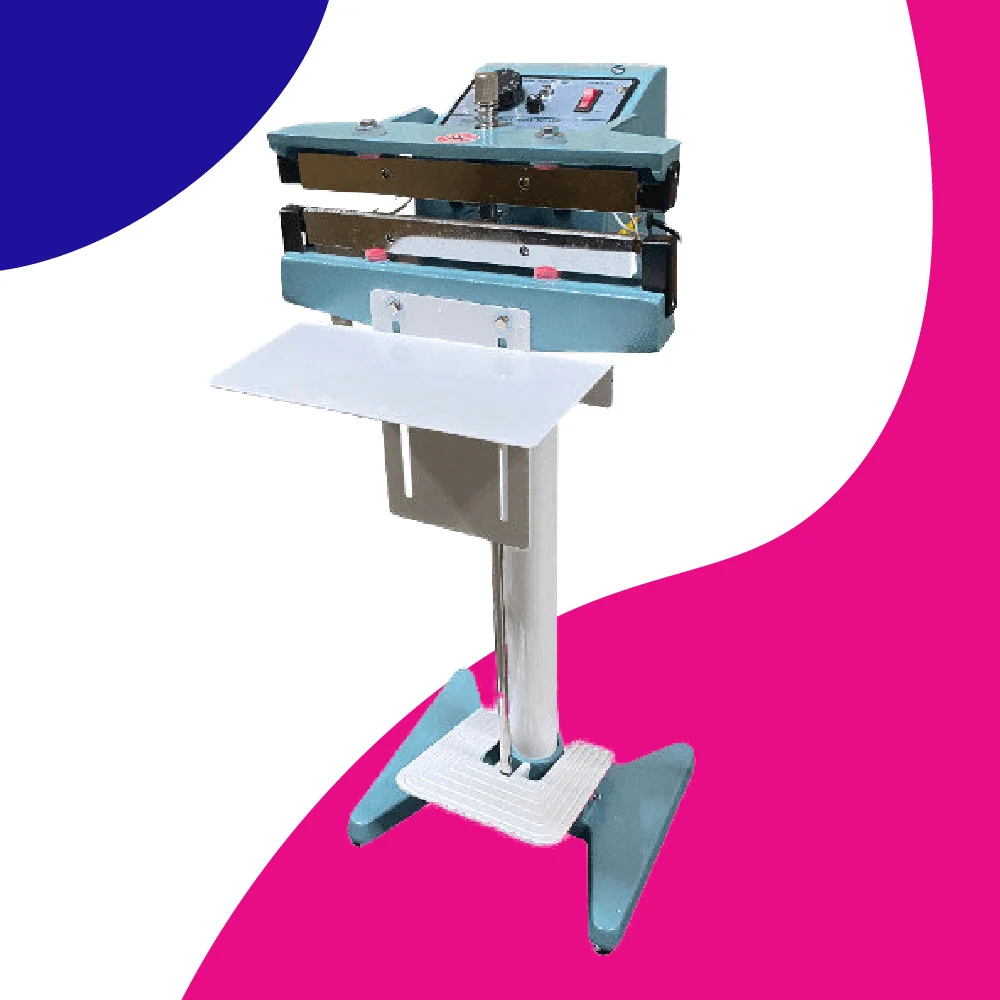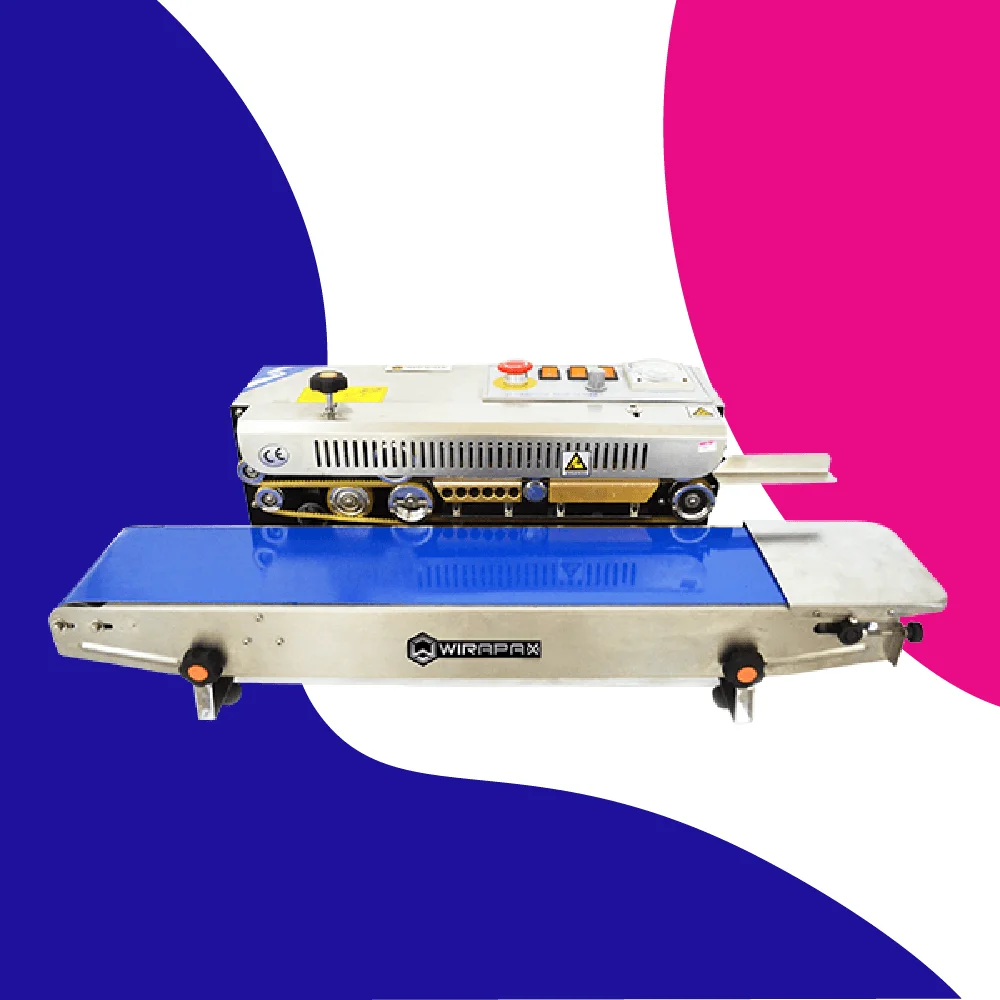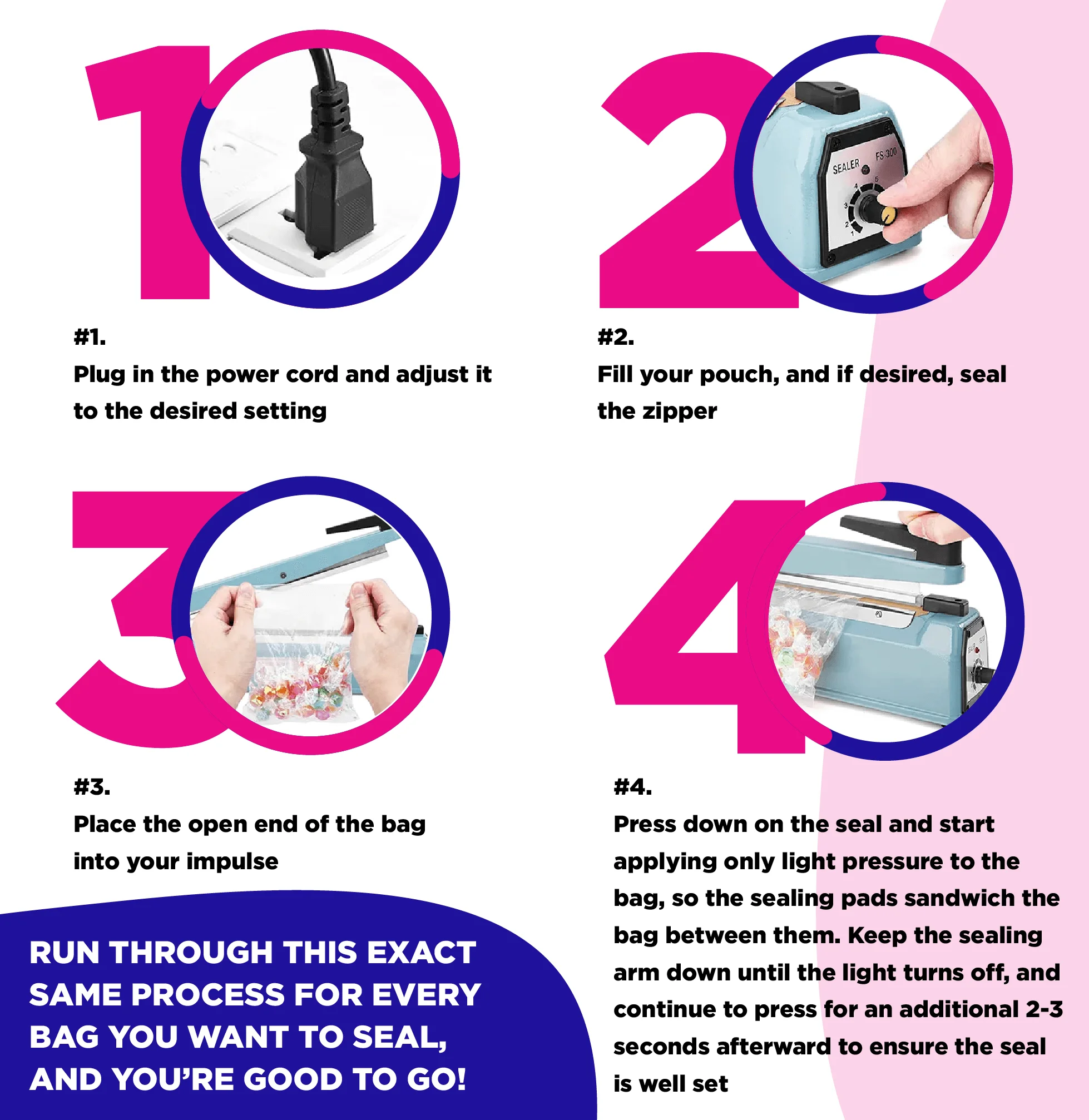No products in the cart.
How to Seal Mylar Bags for Food Storage
Tips for Sealing Bags
How to Seal Mylar Bags for Food Storage


Sealing your mylar bags after loading them is the critical last step before your bulk product is ready to leave your facility and journey to your customer. If your printed mylar bags are not properly or adequately sealed, your product could fall out of its container or prematurely go stale in the pantry, neither of which is ideal for your customer.
Types of Food Storage Sealing Options
When it comes to properly (and professionally) sealing mylar storage bags for storing
long-term, there are four different options: impulse sealing, direct heat sealing, band sealing, or chamber vacuum sealing. Each has its own pros and cons, which you can learn more about below.


Impulse Seal


Impulse seals are inexpensive (starting at around $30 - $100) and provide a quick seal using a pulse of energy through the seal bars. Impulse sealers only turn on when the sealing bars are lowered onto the vacuum seal rolls.
Positives | Negatives |
|---|---|
Inexpensive | Less control that band sealers |
Instant Sealing | Small Seal zone |
Best for occasional use | Manual bag line up creates inconsistent seals |


Direct Heat Manual Seal


Direct heat sealers maintain consistent and constant heat as long as they are turned on. This can allow for better heat penetration and better seal tack.
Positives | Negatives |
|---|---|
Best for thick materials | Cannot seal polyethylene |
Industrial bags o irregular bags | Slower than band sealers |


Band Seal


A band sealer is a semiautomatic sealing machine. Unlike a manual sealer, a band sealer contains both heating and cooling elements. The hot and cool elements combine to create strong, durable, and professional seals on your bags. These direct heat-style sealers typically have separate controls for both temperature and dwell time. A small conveyor with speed controls will pull your bag through the sealing mechanisms, and once set up, hundreds of bags can be processed at one time.
Positives | Negatives |
|---|---|
Very consistent seals seal hundreds of bags in a single use | More expensive $500+ |
Accessories such as date code, serial number stamping | Not ideal for sealing a few bags occasionally |


Chamber Vacuum Seal


Chamber vacuum sealers can be used to seal certain types of mylar bags. These machines are different than the traditional “at home” or food-saving type vacuum sealers that are used by preppers in their home kitchen to vacuum seal bags. A chamber vacuum sealer will both vacuum out most of the air from the bag and also heat seal it at the same time.
Positives | Negatives |
|---|---|
Removes oxygen from the pouch extending shelf life. | Not compatible with all materials. |
Print can get distorted when the bag is vacuum sealed. | Quality chamber sealers start at around $850. |
Sealing mylar bags with an impulse sealer
If you have an impulse sealer, here’s a visual of how you’d use it to seal a mylar bag. We’ll walk you through the process step-by-step below.


Heat Sealer Heat Setting- Food Storage
The question is often asked “What temperature setting do I use to seal my bags?” This question is pretty straight forward but the answer to it can be effected by many variables. Setting your heat-sealing machine to the right temperature is only one factor. Other factors include how long heat is applied to the material (dwell), and how much pressure you apply while sealing. One temperature, Dwell, and PSI setting is not uniformly recommended for each material. For example a better seal can sometimes be obtained with a lower temperature allowed to dwell longer allowing the sealant layer polymers to fully melt together.
Material | Temperature Setting Range | PSI | Dwell Time |
|---|---|---|---|
CareSilver (VMPET) | 350F - 400 F | 40 PSI | 1 Sec |
CareFoil (Aluminum) | 400 F - 450 F | 40 PSI | 1 Sec - 1.5 Sec |
CareFoil-N (Nylon) | 450 F - 500 F | 40 PSI | 1.5 - 3 Sec |
CareKraft (Kraft Paper) | 400 F 425 F | 50 PSI | 2 Sec |
CareClear (PET) | 350 F - 375 F | 40 PSI | 1 Sec |
Factors effecting heat sealing settings to use
Many customers focus on the machine settings when dialing in their heat seal settings, but all the factors below should come into consideration to get the highest strength heat seal.
Material Type
Seal strength, and sealer machine settings will be adjusted to the physical properties of the material being sealed to. Clear PET based material generally will use different settings than nylon or foil based material. The material thickness, flange or surface design, physical pouch configuration, size, and feature placement will also be considerations. Some materials like Carefoil reduce the amount of heat that can get through to the sealant layer so they require more heat or long dwell time. Material Thickness can effect the overall mount of dwell that is required.
Dwell
Dwell time relates to how long heat is applied to the pouch. Heat and dwell time are not independent variables, they go hand in hand and should not be evaluated separately. Dwell time requires adjustment based on the same factors that effect temperature. Some heat sealable flexible barrier materials require lower heat for a longer time to properly sell. While you can "seal" a bag with high heat for a short duration. The sealant layer may not form a high strength bond.
PSI
The pressure at which heat is applied to the pouch can effect bag seal strength.The amount of pressure applied by the heat-sealing equipment will create differences in the heat and dwell settings. Thicker materials and those which are more rigid such as CareKraft require more pressure, while with thinner materials if too much pressure is applied the heated selant layer can be pressed too thin.
Fouling
Fouling can occur during the loading process particles, dust, or liquid we left in the sealing zone. If so, these contaminates can affect the settlings required on your sealing machine to seal the bag properly. Foreign material in the seal zone can also reduce the seal effectiveness. Powder products are notorious for causing fouling. Dust acts like corn meal on the bottom of a baking pan inhibiting the polymers from adhering to each other.
Type of Machine
The type and condition of your heat-sealing machine will create another variable to consider. There are several types of heat-sealing machines and how these machines apply heat. Types of heat sealers include Impulse sealers, roller sealers, platen seal.
External Environment
There isn’t going to be an exact specification because proper temperature will vary widely based on the conditions mentioned in this article. But here are some of the settings that have been reported to us by customers, as well as our own understanding.
Tips for Sealing Mylar Bags
If you’ve never sealed mylar bags before, here are some tips that can help:
Mylar Bag Sealing: FAQs
Here are a few of the questions we get a lot about sealing mylar bags for food storage. For more information, feel free to contact us directly.
Q: What thickness of seal should be used?
Impulse sealers typically offer 2mm, 5mm, or 10mm seals. While thicker is usually better, you’ll want to adjust the thickness based on the type of product and bag. A 2mm seal is usually only suitable for thin polybags, most mylar bags should have at least a 5mm seal applied to it (for prospective ¼” is about 6.35mm), a 8mm or greater seal is often required to prevent bag bursting.
Here are some typical considerations:
Matching the other seals on your bag.
Sealing the entire “top” of the bag is sometimes required.
Note: make sure that you never seal through or below the tear notch. Doing so will make your bag unable to be opened except by using scissors.


Q: Do you have to vacuum seal mylar bags for food storage?
No, you don’t.
Q: What foods cannot be stored in mylar bags?
Although most foods can be stored in mylar bags, there are some exceptions. Foods high in moisture or oil (raisins, nuts, granola, cookies, chocolate, crackers, brown rice) are not good candidates for storage in a mylar bag.
Q: Do you need a special vacuum sealer for mylar bags?
Yes, you’d need a chamber vacuum sealer. At-home food saver sealers cannot seal these mylar bags because they require the bag to have an embossed pattern to fill the air.
Q: How much heat does it take to seal a mylar bag?
It varies. You will likely need to go through a period of trial and error before determining what amount of heat is required.
Q: Do you offer custom sized beauty packaging?
Sealing bags for food storage is similar to sealing bags for retail. The key consideration includes investing in an inexpensive impulse sealer and adding oxygen absorbers, if necessary.
Tags

